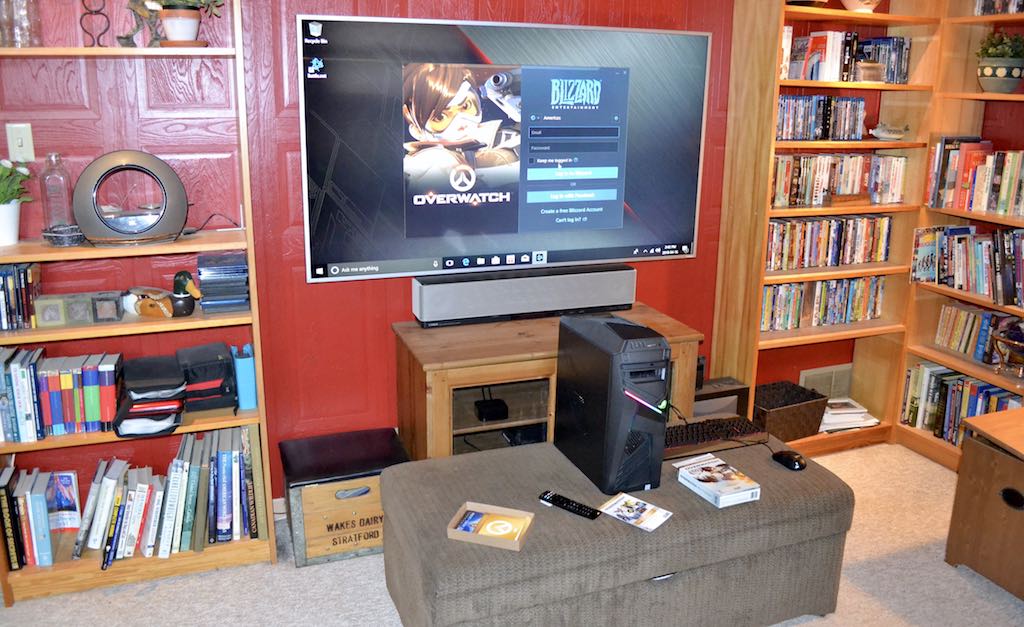
I’ve reviewed quite a collection of gaming laptops over the past six months, but the latest gaming rig to come through my office was a desktop tower. The ASUS ROG STRIX GL12 is big, bold and makes the case that when it comes to high octane PC gaming, full-sized desktop gaming computers still rule the roost.
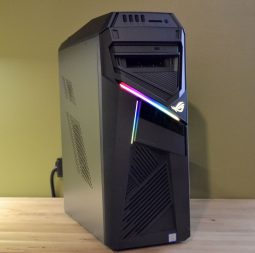 ROG STRIX GL12 proudly wears its ROG heritage
ROG STRIX GL12 proudly wears its ROG heritage
ASUS has built a reputation for offering compelling gaming PCs, including both desktops and laptops, as well as high performance monitors. Its Republic of Gamers (ROG) brand is winning over a lot of PC gamers. Right out of the box, the ROG STRIX GL12 is clearly part of that initiative. Although a large computer (46 cm high, 40 cm deep and weighing 11kg), it manages to pull off a sleeker look than would seem possible given its bulk. There are plenty of sharp angles sculpted into the iron grey and black case, helping to keep it from looking chunky. And on the front face, the ROG logo is prominently displayed and backlit.
Power to spare
One of the great things about tower computers is they have room, and lots of it. That means space for a powerful CPU, a discrete graphics card and other components, along with the power supply needed and the space for an effective cooling system.
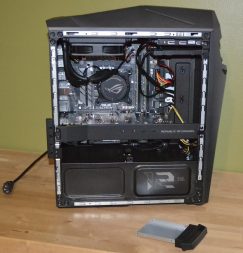 With the ASUS ROG STRIX GL12, that means the latest, 8th generation Intel Core i7 8700K CPU. This isn’t a quad-core CPU, it’s a hex-core and it’s been factory overclocked to hit burst speeds of up to 4.8GHz. It promises performance that’s up to 50% faster than the previous generation chips. There is 16GB of fast, DDR4 RAM to keep it humming, and to ensure the system is as zippy as possible, a 256GB M.2 SSD is used for the OS and key installs. This means the games you play most frequently can be installed on solid state storage for ultra-fast load times. And there’s plenty of room for everything else on the secondary 1TB, 7200 hard drive.
With the ASUS ROG STRIX GL12, that means the latest, 8th generation Intel Core i7 8700K CPU. This isn’t a quad-core CPU, it’s a hex-core and it’s been factory overclocked to hit burst speeds of up to 4.8GHz. It promises performance that’s up to 50% faster than the previous generation chips. There is 16GB of fast, DDR4 RAM to keep it humming, and to ensure the system is as zippy as possible, a 256GB M.2 SSD is used for the OS and key installs. This means the games you play most frequently can be installed on solid state storage for ultra-fast load times. And there’s plenty of room for everything else on the secondary 1TB, 7200 hard drive.
For esports fans, there is also a front-loading, hot-swappable SSD tray. If you compete and need to store customized settings on an SSD, mount it to the tray and it’s ready to go. There’s also an optical drive. And when you don’t need these features, you can cover them with an included magnetic mount plate.
This is a PC gaming rig, so probably the single most important component is the graphics card. ASUS doesn’t disappoint on that front, including Nvidia’s GeForce GTX 1080 graphics card with 8GB video RAM. That’s power to spare for virtual reality. And the company says that in Full HD with settings on Ultra, the ROG STRIX GL12 can run Overwatch at an average frame rate of 150 FPS, and PUBG at 101 FPS.
ROG STRIX GL12 Key Specs (as tested):
|
Customized Aura Sync LED lighting
The ROG STRIX GL12 is built for powerful performance, but it was also designed to look good. The sculpted case is a starting point, but the real star of the show is a customizable Aura Sync LED lighting system. The ROG logo on the front of the case is backlit, and the interior is as well. You can control the lighting effects, which offer 16 million colours.
Out of the box, you can see the interior LED lighting through a grill on the side of the metal case. But ASUS also includes a transparent plastic panel. With a few minutes and a screwdriver, you can swap out the metal side for the clear version, for a full view of the components inside and an enhanced LED light show.
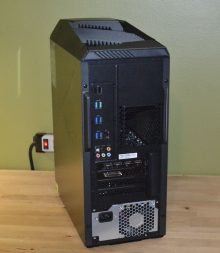
Hands-on
There’s not much to say about the ROG STRIX GL12 that isn’t covered by the specs. My kids fought over taking turns playing Overwatch on it, hooked up to a 4K, 65-inch TV. It performed spectacularly. Of course it was great for web browsing and streaming video but those mundane activities felt like an almost criminal waste on a PC like that. The LED light show is a big cool factor.
Removing the side panel to gain access to the inside for a swap or upgrade was easy. Replacing the side panel with the included clear plastic side panel to make the most of interior LED light show was a simple operation that took maybe two or three minutes.
The only minor complaint I have is that the included USB keyboard and mouse weren’t on par with the computer. They were fully functional and the keyboard had LED backlighting, but like most pack-in accessories, they were on the basic end. Realistically, someone who buys this PC is likely to have a favourite high end mechanical gaming keyboard and mouse anyway, so the included versions are more of a courtesy than anything.
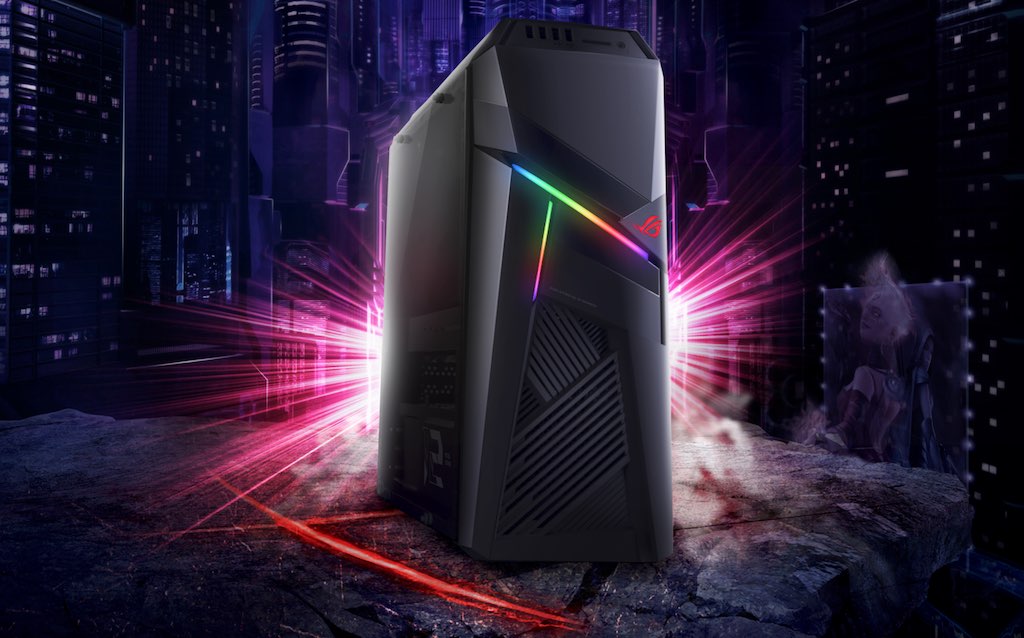
Who is this gaming PC aimed at?
The target demographic of the ASUS ROG STRIX GL12 is hardcore PC gamers, including esports players. It’s not a casual gaming rig. It’s big, extremely powerful right out of the box, highly customizable and expandable. It’s meant to be shown off, not shoved under a desk. You’ll want to have a big monitor to make the most of it, preferably one that supports Nvidia’s G-SYNC technology. If you’re serious about PC gaming, the ROG STRIX GL12 is a gaming PC that’s definitely worth considering.
They’re a big part of the extensive PC gaming selection offered by Best Buy.




how much fps does this run fortnite at?
I didn’t try Fortnite with it, so not sure. I checked Techspot’s benchmarks, and they show the GTX 1080 video card with 8GB RAM that was in my review unit averages 150fps at 1080p with Fortnite settings on Epic.
Why do you review and post a link to a model bestbuy doesn’t even sell? I purchased this machine in your link and it’s vastly different from what you’re reviewing, Which is just great.
Maybe next time specify its a different model or something? I don’t know. Has caused me a lot of hassle.
Manufacturers don’t always supply the exact same models or configurations as those carried by Best Buy, especially in Canada where review unit availability can be limited. Sometimes (as was the case with this PC) they send a review unit months before it actually hits store shelves and specs can change in that time. There can also be multiple configurations carried of the same model (again, as is the case this time). I always try to spike out in the specs at least, that this is the “configuration as tested” to reflect the fact that the review unit won’t necessarily be an exact match for the version carried.
What is the MAX about of RAM this system will take.
It never got especially hot to the touch and the fans weren’t cranked up at any point during testing, but what we were doing probably didn’t have that video card breaking much of a sweat.
Power to spare is right! Did it stay cool throughout your testing?
Comments are closed.